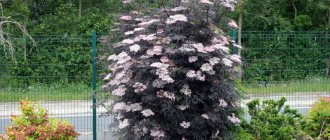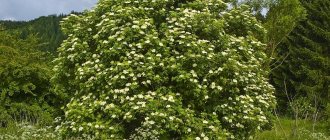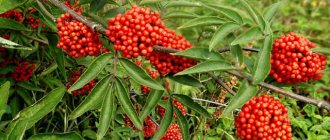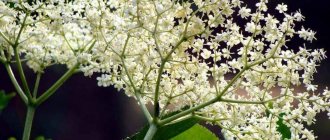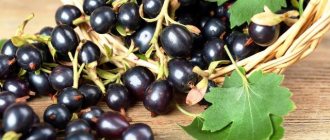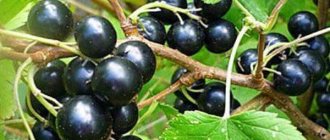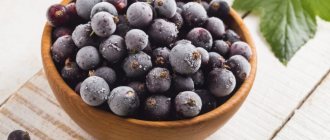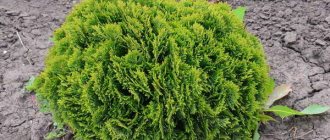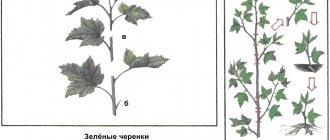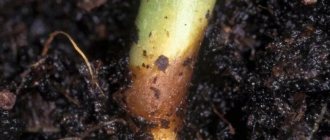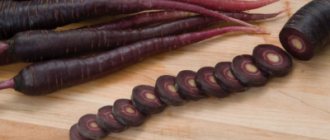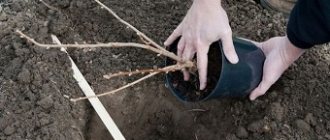Sambucus racemosa Plumosa Aurea. Description of black elderberry Aurea
Elderberry grows in temperate and subtropical zones as a shrub or small spreading tree.
The culture includes more than 15 species distributed throughout Russia, which include decorative forms of black-fruited representatives and shrubs with red berries. One of the varieties in demand for cultivation is the black elderberry Aurea, shown in the photo. Characteristic features of deciduous shrubs:
- It reaches a height of 3 m, the main trunk is thick and dark brown, young shoots are light green. The dense, fast-growing crown resembles a dome and requires constant pruning to maintain its shape.
- The leaves of the plant are odd-pinnate, opposite, yellow in color, and become dark green by autumn. They belong to the complex category and have 6 leaves. In an elongated oval shape, reaching up to 25 cm. The edges are uneven with many well-defined teeth.
- The flowers are small, light beige in color, collected in paniculate inflorescences, and are formed in the upper part of the young shoots.
- The berries are a rich purple color closer to black, small with a diameter of up to 6 mm. The drupe fruit is edible only during biological ripeness.
Black elderberry is grown throughout the central zone, southern regions, and the North Caucasus.
A variety of chokeberry plumosa (pinnate structure) includes the Canadian elderberry Aurea (S. canadensis). Outwardly it looks like black, but there are also distinctive features:
- differs in height, Canadian is about 1 meter taller;
- the inflorescences are large, collected in umbrella-shaped flat panicles with a diameter of 20 cm;
- flowers are white, large;
- the crown is less dense;
- leaves are compound, consist of 7 leaves 30 cm long;
- purple fruits measuring 10 mm.
The culture has a specific pungent odor. It grows quickly and bears fruit at the age of 2 years. The Canadian elderberry variety is less resistant to low temperatures compared to the black Aurea.
The red-fruited representative of the elderberry species, the elderberry racemosa Aurea (Sambucus racemosa, Sambucus racemosa Plumosa Aurea), is grown only for the purpose of designing the territory:
- low-growing shrub (2–2.5 m) with a wide, oval, dense crown;
- the leaves are light green, changing color to bright yellow in autumn;
- Elderberry blooms in early May, after 14 days the bush is covered with scarlet clusters;
- fruits contain a high concentration of hydrocyanic acid;
- frost-resistant variety.
Red elderberry Aurea has a sharp, unpleasant odor that repels rodents and insects, so it is recommended to plant the plant near fruit trees and vegetable crops. For design purposes, it is well suited for border decoration and as a single plant. Does not have decorative varieties. It grows quickly, requires constant formation of the bush, and is demanding on watering. Unlike black-fruited representatives of the elderberry species, red plumosa Aurea is not cultivated on a commercial scale, since the fruits are unsuitable for human consumption.
It is found throughout Russia, except in regions with harsh winters.
origin of name
The name of the variety “Plumosa Aurea” speaks about the nature of the color of the foliage: the first word translated from Latin means “pinnate”, and the second means “gold”. Plants and hybrids described by this phrase have just such a feature - a “golden feature”.
Did you know? In the old days, there was a belief that a man who carried elderberries with him was protected from his wife’s infidelity.
The Latin word "
racemosa
" identifies the type of plant and is related to "racemus" - "brush of grapes". The name is associated with racemose fruiting. Otherwise, the shrub is designated as elderberry or common elderberry.
Elderberry in landscape design
Black elderberry is a very beautiful shrub, so it is great for decorating garden plots. In a small area, black elderberry Aurea is suitable for creating a single-row hedge. Thanks to the unusual foliage and bright flowering, elderberry can be used to decorate almost any decorative composition consisting of large, compact shrubs.
Growing Elderberry Aurea in the garden is not at all difficult. If you provide the crop with basic care, the plant will respond with lush, long-lasting flowering, emitting a pleasant aroma, and will delight you with abundant fruiting. In addition, elderberries are very healthy and tasty.
Landing
Plumosa Aurea grows well in fertile soil. The variety prefers loose soil and sufficient lighting, but in general the shrub's demands on soil and light are low - it develops normally in poorer soil and tolerates partial shade well. The main thing when planting is to ensure that the root collar is at ground level.
It is better to use bushes from 1-2 years old for planting, and you can plant them either in spring or autumn. The earth should be warmed up, so there is no need to rush in the spring, but in the autumn you need to be in time before the cold snaps. You can start planting elderberries in April.
Important! Black elderberries are conditionally edible, while red elderberries are poisonous.
Spring option:
- Four weeks before planting, dig a hole to a depth of 80 cm with a diameter of 50 cm.
- Mix the top layer soil (leave the bottom layer separately) from the pit with humus, 50 g of phosphate and 30 g of potassium fertilizers.
- Fill 2/3 of the excavated area with this mixture.
- During planting itself (after a month), place the seedling in this loosened soil.
- Then start filling with the soil of the bottom layer and mixed soil.
- Compact the area and water the plant with at least 15 liters of water.
- The seedling should now be tied to a stake installed nearby.
Planting in the fall should be done in the same way as in the spring.
It is only important to ensure that the root collar does not go deeper than ground level. The soil mixture can be prepared as follows:
- 2 parts humus and the same amount of turf;
- 1 part peat and the same amount of sand.
Elderberry care
The shrub's requirements are low; for the most part it needs pruning - the shoots age and dry out over the years. In this case, they should be removed under the base. Formative and stimulating pruning of Plumosa Aurea creates a neat appearance of the plant. Read more about this, about watering and fertilizing red elderberries.
Separately, you should clarify the following care measures:
- treating parts of the bush damaged by rodents over the winter with garden varnish or a weak solution of potassium permanganate;
- watering in early spring during dry winter;
- shelter from the cold before winter;
- pest control after flowering;
- loosening the soil around the tree trunk;
- pinching of branch tips due to regrowth in late summer;
- October treatment against diseases and pests;
- insulation by mulching tree trunk circles (peat or foliage is used).
We recommend reading about the herbaceous elderberry.
Watering
To prevent watering work from being in vain, it is important to mulch the ground under the bushes. Compost works well for this purpose. Use plenty of moisture - up to 15 liters of water. Seedlings and young bushes can be watered more often. Removing weeds and loosening will be beneficial. To avoid mistakes with watering, monitor the soil moisture - it should not dry out.
If the summer turns out to be dry, there is no or little rainfall, the plant should be watered once a week.
Fertilizer
Several characteristic features of elderberry regarding its relationship to feeding:
- in fertile soil the shrub grows well without fertilizers;
- nitrogen mixtures, which are introduced in spring and summer, improve the condition of the plant;
- this variety also prefers manure;
- in the fall there is no need to feed the bush;
- Mineral types of fertilizers should be applied in the spring along with irrigation - provided that the condition of the bush has deteriorated.
Trimming
Pruning for elderberry can be both sanitary and formative.
The main actions are:
- in the spring, dry, damaged shoots are removed;
- Once every five years you can radically trim the crown, which will have a rejuvenating effect.
Important! Drastic pruning should be done as follows: cut each shoot to a height of 10 cm.
After severe pruning, the plant begins to grow very abundantly again. So you can shape the bush to your taste, creating a shape when decorating a garden plot, cottage, or park area. It is important to treat exposed shoots with garden varnish, so they will be protected.
Possible diseases and pests
Aphids are the main enemy of any elderberry. Spring treatment with Karbofos will help prevent insect invasion. Use 8 liters of water and 60 g of product; one bush will require 1.5 liters of solution. It is important to irrigate with the preparation a month before the berries become ripe, although for decorative use this is not so important. But the interval between treatments must be observed - wait 10 days between the first and second watering. It is necessary to irrigate the solution so that it covers all parts of the plant.
Aphids can develop a habit of using Karbofos, so the product will need to be replaced with another if pest control is not complete. Preventive spraying with insecticides in early spring is also used in gardening.
The variety is not susceptible to diseases. This feature characterizes the elderberry as a convenient and unpretentious shrub, so Plumosa Aurea is an easy option for decorating your garden.
Dissected leaves and yellow berries
Sambucus racemosa was scientifically described in 1753 by C. Linnaeus, although, of course, it was known before that. This is a very polymorphic species, which is divided into numerous subspecies and forms.
In most of Europe, up to the European part of Russia, Sambucus racemosa L. subsp. racemosa. Sambucus racemosa subsp. grows in the Far East, Kuril Islands, Sakhalin, Korea, and Japan. kamtschatica (EL Wolf (Hulten). In the Far East, Siberia, China and Mongolia, the Siberian subspecies Sambucus racemosa subsp. sibirica (Nakai) H.Hara is common. And in Japan, Sakhalin and the Kuril Islands, Sambucus racemosa subsp. sieboldiana (Miq. ) H.Hara), which is now tended to be considered as a separate species of elderberry Siebold syn. Mikel's elderberry, or Sakhalin elderberry (Sambucus sieboldiana (Miq.) Blume ex Graeben), which is also quite polymorphic in appearance.
In the western part of North America - in Western Canada and the northwestern United States - Sambucus racemosa subsp. pubens (Michx) House var. arborescens (Torr.&A.Gray) A.Gray). But in the south of the United States another, small-leaved form of Sambucus racemosa L. subsp. is already growing. pubens (Michx) House var. microbotrys (Rydb.) Kearney & Peebles, now also acquiring the status of an independent species - Sambucus microbotrys.
Accordingly, the scope for selecting interesting forms is huge. Landscape designers were the first to appreciate elderberry and start working with it. Elderberry is used as an ornamental crop. Even the species common elder delights the eye with lush yellowish-white inflorescences in May and bright clusters of red fruits among fresh green leaves from mid-summer. But it is so common and familiar that its varieties are usually planted in landscape compositions:
Elderberry Plumosa Aurea | Elderberry Sutherland Gold |
- Plumosa Aurea is one of the best, with golden yellow, deeply cut leaves and yellow flowers.
- Sutherland Gold - similar to it, differs in coarser cutting of leaves.
- Tenuifolia is a low, slow-growing variety, with branches bent to the ground and delicate, thinly dissected leaves.
- Laciniata - a form similar to the wild one, but more powerful and with strongly dissected leaves.
- Flavescens - will surprise you with its yellow berries.
Elderberry propagation
These shrubs can be propagated in different ways (seed, layering, and cuttings); the article offers two convenient options - propagation by cuttings and layering.
Important! If you try to germinate the seeds, you will succeed, but young plants may completely lose all varietal qualities.
Growing elderberry from cuttings
To perform this type of reproduction, you need to take the following steps:
- In June, prepare young cuttings up to 12 cm long with three nodes and a pair of leaves on top.
- Treat with a root growth stimulating agent (can be purchased at any garden center).
- Plant the cuttings in soil made of peat and sand.
- Cover with an improvised greenhouse (for example, a bag).
- Next, spray warm water for a week under the shelter, which should work like a greenhouse.
- Do not allow the cuttings to rot.
- In autumn, a rooted shoot can be planted in the ground in warm weather.
Reproduction of elderberry by layering
For propagation by layering, both the youngest and two-year-old shoots are used. They should be bent to the soil and placed in holes with compost. To hold the branches, you can use hooks and metal stakes (special hooks for tourist tents are convenient). Layers are dropped in, and the top is left in the air.
Important! The green branches of the first year are detached only after a year - they must become woody and strengthen, and not just take root.
If the shoots are removed in May, then in the coming autumn they can be cut off from the main bush and replanted.
What does the plant look like: characteristic features
As a representative of the black tree elder, Aurea grows in the form of a powerful bush or even a small tree.
Its height reaches a maximum of 3 m, and the crown is like a dome. The decorative effect of a tree begins with its bark. The central shoots are covered with dark brown bark, while the young branches have light green bark. The branches bear opposite, odd-pinnate leaves, large, divided into 6 lobes. Their length can reach 25 cm, and the edges of the leaf plate are decorated with small teeth. The leaves are a rich lemon-yellow color and retain it throughout the season. Only in the fall do they darken a little and a green tint appears. At the beginning of summer, delicate beige inflorescences - panicles consisting of small flowers - begin to bloom on the lemon crown. In early September, the black berries with a purple tint ripen.
Elderberry Aurea berries are edible. You can use them to prepare compotes, jams, wine, and juice. However, they set only on two-year-old shoots. This must be taken into account when pruning a tree.
